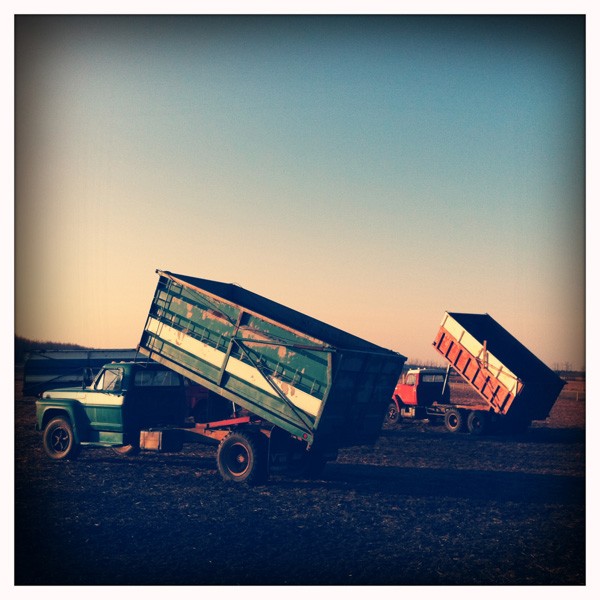Neon Prairie Harvest Time

Pink wheat – seed grain that’s been treated with fungicide – doesn’t taste like strawberry bubble gum. It tastes like death.
This was the sort of scare-mongering reserved specifically for farm kids of the late 1980s, a curious lot eager to explore the wondrous contents of grain hoppers, take livestock on as pets, and toggle every fascinating lever and button in the tractor cockpit – so long as no adult was looking on.
It reflected a time when farming began to be clearly dominated by technology and kid-rearing by hand-wringing.
Freewheeling fun was still to be had (a liquored-up farmhand would still let you ride across fields at high speeds in the open bed of their pickup if you whined loudly enough), but in increasingly short supply.
So too was the expectation of pitching in to bring in the summer harvest. Children were no longer seen as tiny work units, able to pile freshly cut hay into mountainous stoops on a single dose of home-brewed lemonade.
My two younger brothers and I were hapless little threats, in need of constant surveillance lest we find ourselves in harm’s way. Keys to tractors were hidden, barn doors were double-bolted, and livestock moved to pastures too far away for our legs to comfortably carry us.
After all, it was a dangerous time for the harvesters, too. They worked endless hours in the field, and made good use of the bountiful daylight to tackle summertime maintenance projects, like fixing fences, erecting buildings, and repairing equipment. They were punch drunk from too little sleep and too much physical labour. Slipping up seemed inevitable.
My father, in a recent conversation for this piece, shares some of his foibles. My mother, listening in, cringes in remembrance of the time when my father did a backwards somersault off the 24-foot high building he was helping construct, landing on his face. He was in the hospital for a week and a half; she was pregnant with one of my younger brothers.
When the harvest crew – a friendly group of about 10 neighbourhood men who came together to help each other tackle each other’s collective field work – arrived on scene, we were on lockdown.
We became the chattels of my mother, whose singular focus was to win the unstated competition of whose cooking would result in the biggest waistline gains for the harvest crew.
She frequently emerged victorious.
Children were no longer seen as tiny work units, able to pile freshly cut hay into mountainous stoops on a single dose of home-brewed lemonade.
These men were a hungry bunch. They needed heavy lunch, a mid-afternoon meal, and a gargantuan supper later in the evening. Every day, she would make four pies, and a cake, boil 10 pounds of potatoes, cook up 20 pounds of meat, bake two dozen buns, and prep a dozen sandwiches.
For a week each year, we adapted to a new daily rhythm, punctuated by the hunger pangs of these hard-working men and an even harder-working woman.
We’d clean the carrots, shell the peas, and wash the lettuce we’d collected earlier in the day. We’d wade through her hundreds of strawberry plants to find the perfect berries to accompany her shortcake. We’d set the table for 14, folding napkins into origami shapes, and making sure there was room in the center for the seven or so dishes (at least two of which were meat) that my mother had simmering on the stove.
We’d help her clean the table and do the dishes. We’d sweep the floors. We’d nap. And, a few hours later, we’d start over again.
When we were old enough, we’d have the privilege of bringing a later afternoon snack – usually a heavy sandwich, beer, and cookies – to the field. We’d fight for this privilege. Once, my brother jumped into the moving truck I was captaining, throwing in the sandwiches and beer before he made his leap. The sandwiches made it in fine; the beer bottles exploded on impact, sending foamy glass shrapnel everywhere. I still have a scar.
Looking back, these memories are obvious reminders of the important links between food and community. But back then, harvest wasn’t a time when farm life could pause to consider the cycles of the food chain and our role in it. We were too busy making – and breaking – bread together to really notice.
Main photo “Lined Up” by Alistair Henning. Additional photos by Paula E. Kirman.
Carol is a resident of Boyle Street.










